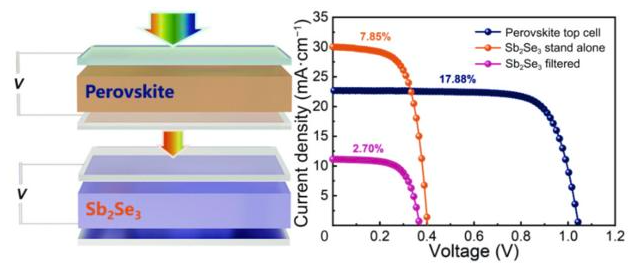An international group of researchers from the University of Science and Technology of China developed a proof-of-concept tandem solar cell tandem solar cell for the first time by using antimony selenide for the bottom cell and a wide-bandgap organic-inorganic hybrid perovskite material for the top cell. The research was published in the journal Energy Materials and Devices.
 Demonstration of a proof-of-concept tandem solar cell composed of antimony selenide and wide-band-gap perovskite as bottom and top subcell absorption materials. The device achieves a greater than 20% power conversion efficiency by optimizing the transparent electrode of the top cell and the preparation process of the bottom cell. Image Credit: Energy Materials and Devices, Tsinghua University Press
Demonstration of a proof-of-concept tandem solar cell composed of antimony selenide and wide-band-gap perovskite as bottom and top subcell absorption materials. The device achieves a greater than 20% power conversion efficiency by optimizing the transparent electrode of the top cell and the preparation process of the bottom cell. Image Credit: Energy Materials and Devices, Tsinghua University Press
The device obtained a power conversion efficiency of more than 20%. This study demonstrates that antimony selenide has a high potential for bottom-cell applications.
Photovoltaic technology transforms sunlight into electricity and is popular because it offers a clean, sustainable energy source. Scientists are still working to enhance the power conversion efficiency of solar cells.
They attained more than 20% power conversion efficiency in conventional single-junction solar cells. Achieving power efficiency over the Shockley-Queisser limit in single-junction solar cells would be substantially more expensive.
However, the Shockley-Queisser limit of single-junction solar cells can be circumvented by creating tandem solar cells. Researchers can achieve improved energy efficiency using tandem solar cells by stacking solar cell materials on top of one another.
The study team created tandem solar cells using antimony selenide, a semiconductor. Previous research on antimony selenide has mostly focused on uses in single-junction solar cells. However, the study team recognized that, in terms of band gap, this semiconductor could work as an ideal bottom cell material for tandem solar cells.
Antimony selenide is a suitable bottom cell material for tandem solar cells. However, because of the rarity of reported tandem solar cells using it as a bottom cell, little attention has been paid to its application. We assembled a tandem solar cell with high conversion efficiency using it as the bottom cell to demonstrate the potential of this material.
Tao Chen, Professor, Department of Materials Science and Engineering, University of Science and Technology
Tandem solar cells can absorb more sunlight than single-junction solar cells, which employ only one layer of semiconductor material. They also convert more sunlight into electricity, making them more efficient.
The researchers created perovskite/antimony selenide tandem solar cells with a transparent conducting electrode for optimal spectral response. They modified the thickness of the top cell’s transparent electrode layer and achieved an efficiency of more than 17%. They improved the antimony selenide bottom cell by adding a double electron transport layer, resulting in a power conversion efficiency of 7.5%.
When the top and bottom cells were mechanically assembled to form the four-terminal tandem solar cell, the power conversion efficiency hit 20.58 percent, outperforming the independent subcells. Their tandem solar cell is highly stable due to its non-toxic compositional elements.
Chen added, “This work provides a new tandem device structure and demonstrates that antimony selenide is a promising absorber material for bottom cell applications in tandem solar cells.”
Looking ahead, the team intends to develop a more integrated two-terminal tandem solar cell and enhance device performance.
“The high stability of antimony selenide provides great convenience for the preparation of two-terminal tandem solar cell, which means that it may have good results when paired with quite a few different types of top cell materials,” Chen stated.
Zhiyuan Cai, Huiling Cai, Yuehao Gu, Rongfeng Tang, Changfei Zhu, and Tao Chen from the University of Science and Technology of China, along with Jia Sun and Paifeng Luo from Hefei University of Technology form the rest of the research team.
National Key Research and Development Program of China; National Natural Science Foundation of China; School-Local Cooperation Industrial Innovation Guidance Fund Key Project, Hefei University of Technology, China; Wuhu Major Engineering Application Project, China; and the Collaborative Innovation Program of Hefei Science Center, CAS funded the study.
Journal Reference:
Cai, Z., et al. (2024) Sb2Se3 as bottom cell material for efficient perovskite/Sb2Se3 tandem solar cells. Energy Materials and Devices. doi.org/10.26599/emd.2024.9370027.